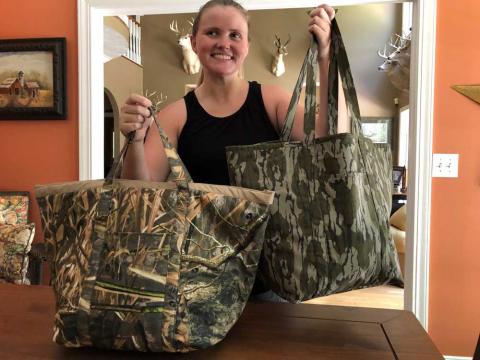For the last 20 years, Mossy Oak ProStaffer Ralph Ramos of Las Cruces, New Mexico, has called in a bull for himself or his clients every opening weekend, which is usually Labor Day weekend. Ramos has been hunting mule deer and elk in New Mexico for almost his entire life, about 43 years. Archery season for mule deer and elk starts on September 1. All elk and mule-deer tags in New Mexico are assigned through a lottery system. In other words, you apply and then are notified if you’ve been drawn to hunt either of these two species. There are also private-property tags that can be purchased for mule deer. For elk, ranchers get authorization, and then you can buy a tag from the ranchers.
There’s Plenty of New Mexico Wildlife to Hunt Starting September 1st
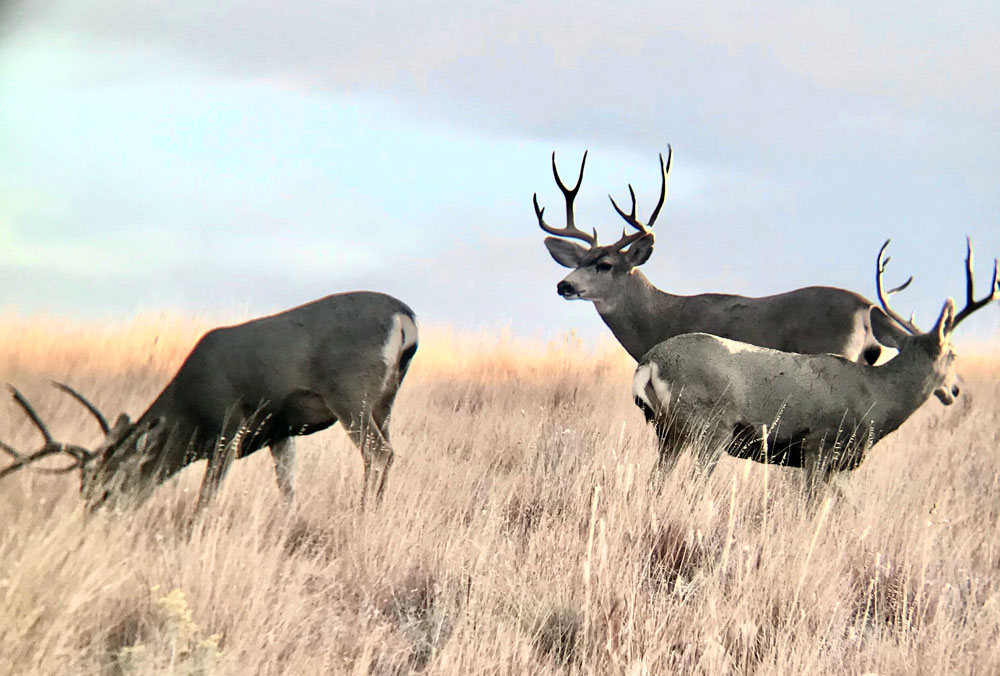
We have three different subspecies of deer here in New Mexico - Coues deer, mule deer and white-tailed deer in the eastern part of the state. Coues deer are found mainly on the southwestern corner of New Mexico from the boot of New Mexico to the Gila. On the eastern side of the state, if you’re going to hunt mule deer or whitetails, you have to specify which species of deer you want to hunt when you apply for a tag. You can’t get a tag that includes elk and deer. So on September 1, you have three species of deer you can hunt with a bow as well as elk, unless you have a private landowner combination hunt.
In September, I hunt elk, and I hunt mule deer in October during their rut. When I’m hunting mule deer, I like to hunt the last weekend of deer season around October 31st. Generally at that time, I’ll put down my bow and pick up my muzzleloader. That last week in October is just before our rifle season in New Mexico. Opening weekend for bowhunting elk is one of my favorite times of the year. I use a lot of cow calls as well as rattling and raking trees with elk antlers to get bulls to bugle. At that time of the year, the bulls really don’t want to talk (bugle), but by using these techniques, I usually can get an elk to bugle enough to give away his location. Or, I can stimulate him enough to get him to come in to calling just to find out what’s happening.
Many areas we hunt on that first weekend of elk season will be bedding places where we find numbers of droppings, and the region will smell like elk. Often, when we get a bull to bugle, we’ll give him a bugle call, and then start crashing antlers together and raking trees with elk antlers. I don’t do much scouting at the first of the season. I’ve hunted so long in this section of New Mexico that I know where the elk usually are, whether our area’s having a dry year or a wet year.
My main job is to get an elk to bugle. Once we get him bugling, then we can hunt him. Although sitting over water holes and waiting for elk to come to water is an often used and very successful technique for taking bulls, for me the thrill of elk hunting is calling those bulls in to within bow range.
Tactics for Taking an Opening Weekend Bull Elk
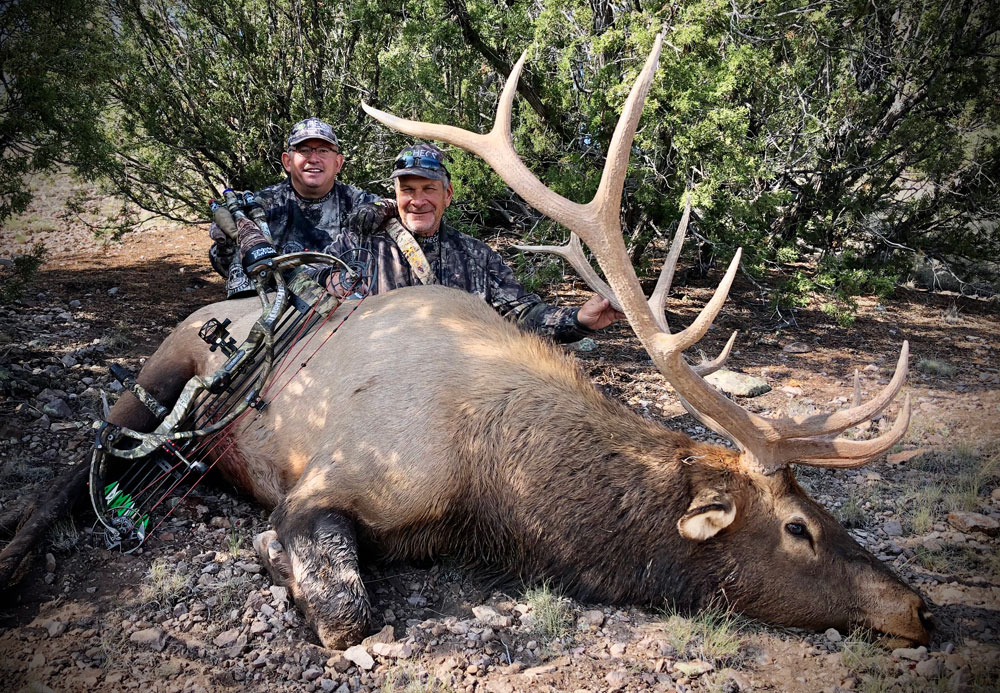
I had a great hunt with a friend of mine, Jay Jarden, who’s also from Las Cruces, on opening weekend of 2020. We both shoot PSE Bows - carbon bows and the latest EVO models. We both shoot about 70 pounds and use fixed broadheads.
As soon as we got out of the truck on this hunt, our plan was to walk down this long ridge. I planned to work a series of different calls made by various manufacturers to try to get an elk to bugle. I use Rocky Mountain Elk Calls, Will Primos Calls and Wayne Carlton Calls. I believe using calls from different manufacturers is one of the reasons I have such good success calling in bulls. Each manufacturer I’ve mentioned makes great elk calls, but they all sound different. I want to sound like different bulls or cows every time I blow a call. Each individual cow sounds different when she calls, as does each bull. Some elk call with high-pitched tones, while others call with low-pitched tones. Some bulls sound more like they’re squealing when they bugle, and other bulls sound like they’re growling. So, I believe you need an assortment of calls when you’re trying to work a bull into bow range.
Every time I guide hunters, we usually average taking a bull out of every two days we hunt. I only hunt public lands, in the Lincoln National Forest. On this particular hunt last season, I went to this long ridge that I’d hunted during early season for many years and called in bulls there every season. You could walk a long way along this ridge, and we usually could get a bull to bugle on this ridge during opening weekend.
I’ve developed a technique I call the X-on. Once we hear an elk bugle, I sit my hunter in a spot where I think the elk will come to, then I get about 75-100 yards behind my archer, but within sight of him and start calling to the bulls. If the bull sounds like he’ll come in to the right of the hunter, I’ll move to the hunter’s left to call, so the bull will walk in front of the hunter. If he sounds like he’s going to the left of the hunter, I’ll move to the right.
When we heard the bull bugle on mine and Jay’s hunt at the beginning of elk season, 2020, the bull bugled across the canyon about 400 yards from us. Because I’d hunted this area so much, I knew that the ridge we were on would meet the ridge the elk was on where the two ridges came together and made a bowl on the north end of the ridge. With a lot of timber there, the area was very shady and therefore cooler than either ridge. That was where the bulls usually went to bed. I also knew that the trail that the bull was on was the path of least resistance to reach the bowl. So, we hurried back to the bowl to get there ahead of the bull. The bull was bugling often to the cow calls I was giving as we were walking. I used a cow call that sounded like the cow that was leading the herd, and gave various cow calls and calf calls as I moved to the point where I thought that the bull would come.
When we got close to the back end of the shaded bowl, the bull stopped bugling. I bugled to him to make the bull think another bull was traveling with the herd of cows I’d sounded like. However, I didn’t give him a full bugle – but more of a moaning bugle that sounded like a growl and a chuckle. Then I followed that bugle with many different cow calls. As soon as the bull heard me moaning and chuckling on the bugle, he bugled back. I could tell he was on the way to us. We finally saw him coming from about 150-yards away. Jay and I both were wearing Mossy Oak’s Break-Up Country pattern. I had Jay set up in front of a big tree with a clear view in the direction from where the elk was coming.
I think seeing a hunter in camouflage doesn’t spook an elk, however seeing a hunter in camo move will spook an elk. That’s why I also believe in the HECS suits and wear them. The elk don’t seem to pick up on the vibrations that a hunter gives off when the hunter’s wearing HECS with their sixth sense that they often use to know there’s danger near.
Jay already had nocked an arrow and was getting ready to take the shot before he actually saw the elk coming. The bull got closer and closer to the 30-yard range that Jay had picked out for shooting. I like for my hunter to decide when he wants to draw a bow, when the elk is 20-40 yards from him. As soon as that bull got his head behind some tree or brush where he couldn’t see Jay move, Jay came to full draw.
Once the elk was at 40 yards, I quit calling. Jay was at full draw, and the bull was coming at a fast trot, head-on, to Jay. As a seasoned elk hunter, Jay didn’t look at the elk’s antlers anymore but rather concentrated on the spot where he wanted to put his arrow. You want to imagine a line going from the bull elk’s brisket toward his rear and a line that comes straight up from the elk’s shoulder intersecting that line from the elk’s brisket, about one-third of the way up from the elk’s belly. When the bull was at 18 yards, Jay had a cow call in his mouth and gave the bull a soft cow call before releasing his arrow. But Jay had gotten excited, and his arrow hit the bull a little bit behind the crease and somewhat high.
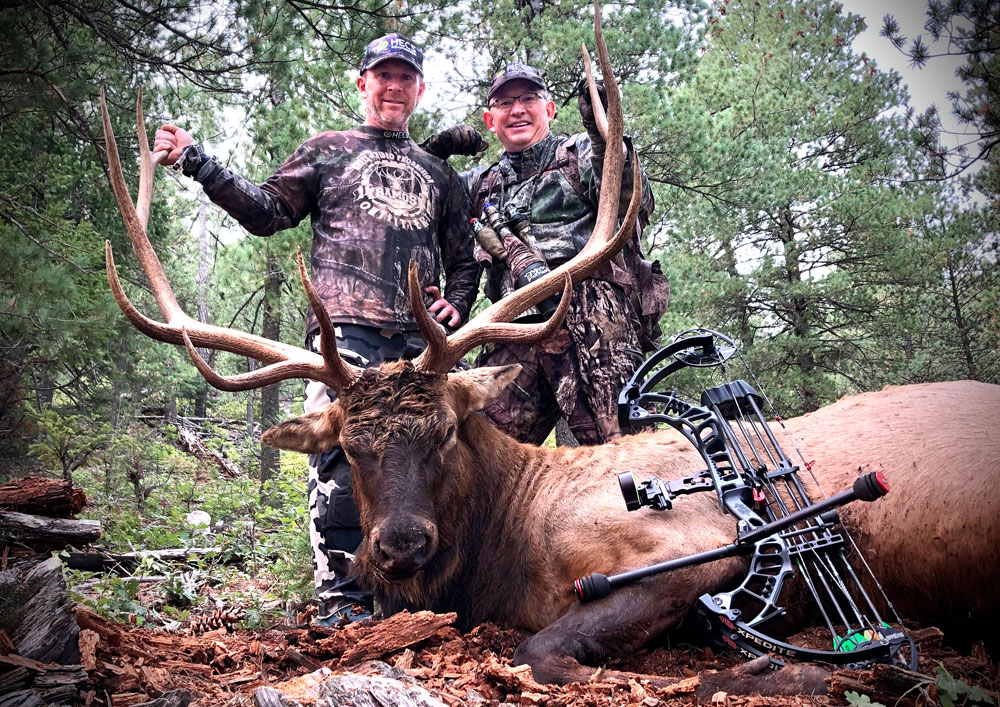
One of the advantages I have when I’m guiding someone is that I take a video camera with me to video the hunt and also to replay the video after the elk has been arrowed and see exactly where the broadhead’s hit. Then we know how long we should wait before we try to go recover the elk. I always want to wait at least 5 hours before I attempt to recover any elk that’s arrowed.
Jay’s bull went about 300 yards, and we saw him lay down. We backed out, waited a little while, snuck back in and saw that he still had his head up. So, we backed out again, we went to the truck, and we waited until 2 p.m., because Jay shot the bull at 9 a.m. Then we went back to the bull and saw that he’d expired. The bull was a good 6x6 that scored about 330 inches on Pope & Young (P&Y).
Consider the Heat When Hunting Opening Day Elk
The temperatures during opening weekend of archery elk season in New Mexico usually will be 70-80 degrees. So, getting the meat out quickly is critical. That’s why I like to debone the meat and get the meat and the head out as quickly as possible to put it into an ice chest, a walk-in cooler or a freezer. A bull elk will produce about 300 pounds of boned-out meat, and two men generally can get that much meat out in backpacks in two trips to their vehicle.
On Jay Jarden’s hunt, his girlfriend Kelli Younker had come with us and was filming the hunt. So, we had three people who could carry out the meat and the head. Kelli carried about 60-70 pounds of meat, while Jay and I packed out the rest of the meat and the head.
I use Eberlestock Blue Widow backpacks. I like this pack because it’s really comfortable, and the design of the pack lets most of the weight sit on your hips rather than on your shoulders. It’s also padded very well, making it more comfortable for carrying a heavy load. It packs down really small too when you’re actually hunting. But then, when it comes to packing the meat out, the bag expands to enable you to carry out a heavy load of meat. I’ve used these packs for the last 15 years, and they are very durable. I still have the first Eberlestock pack I bought in Mossy Oak camo.
When we got back to our truck, we left the meat in our backpacks. Then when we were driving out, the meat didn’t get dusty. Also, when I was boning the meat out in the field, I put the meat in Ziploc bags to keep the meat from getting dirty or getting any hair on it. Then when I get back to camp or back to the house, I could start freezing those bags full of meat.
Go Dark for Elk and Use Various Calls
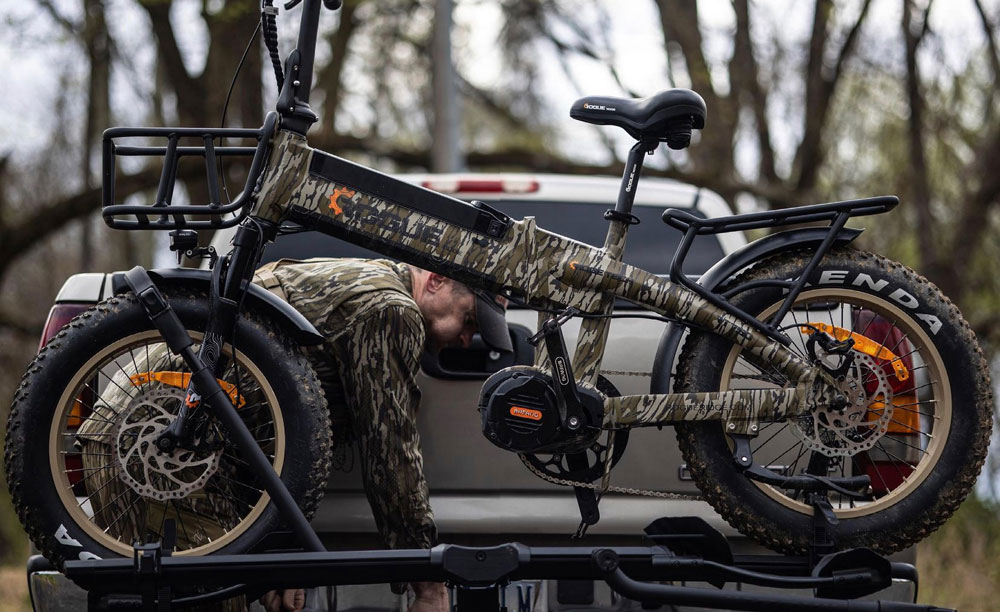
I like to reach the spot where I’ll start hunting from while the day’s still dark. I want to get ahead of any other hunter who may be hunting this same area. So, I’ll usually hike in at least a mile before I start calling. Or, I’ll ride my Rogue Ridge Grinder E-Bicycle, an electric assist bicycle that enables me to go 25 miles in mountainous terrain or 75 miles off one charge on flat ground. I also have a trailer on the back of the bike with which I can take gear in and meat out. The bike allows me to ride in early with a light down a logging road for 2-3 miles into the area where I plan to begin hunting and arrive at my destination quietly.
I believe that one of the main reasons for my success in calling elk is because of the lanyard of elk calls that I wear around my neck. I like the Rocky Mountain Elk call made by Rockie Jacobsen. I think he has some of the best diaphragm calls on the market, and I like his bugles too. They’re easy to use, and they sound like elk. Too, they fit my mouth really well, which is one thing you need to consider if you’re going to use a diaphragm mouth call. Don’t buy one that almost fits. Select a call that comfortably fits in your mouth. Believe it or not, various folks have different-sized mouths. So, if you’re going to use a diaphragm, get one that fits comfortably and works well for you. I use diaphragms to bugle and to cow call.
I’ve used Primos elk calls for a long time - maybe 20 years - and I like the original Blue Reeds calls. They’re easy to use, and they’ve proved in the field that they bring in bulls. I use Wayne Carlton’s diaphragms and reed calls, and his Resonator bugle tubes. I like the Abe & Son elk calls, because I feel like I can show more emotion with these calls than I can with other calls. They’re somewhat more difficult to learn to call with, but they sound good and are very realistic. I’ve also got the FoxPro resonator call. The reason I like this call is because it has a mechanical button on the resonator chamber that I can open and close. When I open the call, it sounds loud, and I can muffle it down to give a lighter, softer call. This call is probably the easiest call to use to vary the elk tones you give, and I can use it for bugling.
On my lanyard, I’ll have six calls wrapped up together to have the calls within easy hand reach. Having my calls lined-up, I quickly can move from one call to another. Because of the way I have my calls bundled, I can sound like a herd of different elk, both cows and bulls, by just moving my mouth from one call to the next call in the bundle. I think elk are sometimes like turkeys. Oftentimes they’ll react and bugle to one of those calls, when they may not bugle to any other call in my bundle.
When I first reach the spot where I want to start calling, I’ll start off with a slow, soft calf call. That way if there’s an elk close by, I probably can get him to bugle. If I don’t hear anything respond to the calf call, I’ll switch to a louder cow call. When I get that first bugle, I like to close the distance that my hunter and I are from the elk. If the elk is 300 yards from where I am, I want to move as quickly as possible to cut this distance we are from the elk to about 150 yards.
I don’t worry about the elk hearing me as I’m moving because elk are big animals. When they go through the brush over rocks or through timber, they make a lot of noise. So, if the bull has heard a cow call or bugle and answers that call, he expects to hear cows, calves and possibly bulls coming to him. As I move toward the bull, I’ll be calling with all the different calls, and usually he’ll keep bugling to let me know where he is. But when I get to within 200 yards of where I think the bull’s bugling, I like to set my hunter up to face the direction I think the bull will be coming from, and then back off 50-75 yards from where the hunter is. Then I can see him and the bull as he’s coming.
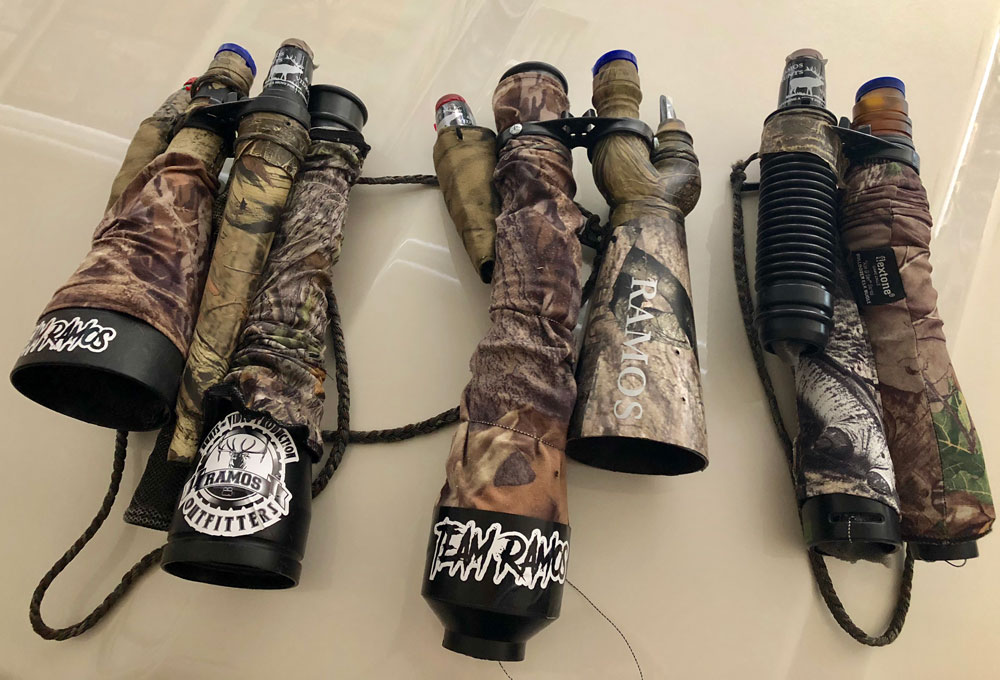
Ralph Ramos Guides Bowhunters to Elk and Explains the Importance of Videoing
My elk hunt with my friend of many years took place in the Gila National Forest. Jeff Terranova is a veteran hunter, and he’s not interested in just shooting a bull. For that reason, he’ll pass up numbers of bulls other hunters may take. And, on this 5-day hunt, we did pass up numbers of bulls. We were hunting in more open country, so we could see and call in bulls that we might not have been able to call in from more wooded areas. The bulls in open country tend to bugle better than the bulls in timber.
Jeff and I have hunted many years together, and he’s a very experienced bowhunter. I hunt with Jeff in a different way than I do most of my other hunters. I let Jeff walk out in front of me when we hear an elk bugle - he’ll usually be 60-80 yards in front of me. As long as I can see Jeff walking toward a bull, I’ll continue to call. At some point Jeff will stop, and then I’ll stop walking but still call. I try to determine whether Jeff will continue to move, or whether he’s seen a cow elk and stopped to not spook her. When he spots an elk, he’ll stop, so he won’t spook the herd. If Jeff sees a herd of elk coming to him, and there’s a bull in the herd, he’ll squat down by a big tree or a very thick bush. He’s probably already nocked an arrow. I can tell by his body language, and what he’s doing, what he sees, and if he’s got a bull spotted that’s coming toward him. If I can see the elk also, then the next thing I’m looking for is to see in which direction Jeff is facing, and when he’ll draw his bow. I also watch for Jeff before he draws to look behind the elbow with which he’ll draw.
One time when we were hunting together, Jeff had a very nice bull coming in, the bull was at 30 yards, and Jeff drew his bow. When he drew his bow, his arm hit a dry branch behind him, a twig snapped, and that nice elk blew out of there. Jeff didn’t get a shot. So, one of the things I warn my hunters about is to make sure before you draw that you know no twigs or sticks are behind you. When you draw the bow, check that your elbow won’t hit anything that will move and give away your position.
In that five-day hunt, I probably saw Jeff set up to take a shot on eight different bulls. But as those bulls got in close enough for Jeff to shoot, he could tell they weren’t the bull he wanted to take, and he’d let them pass. Finally, though, he spotted the bull he knew he wanted to take. This bull was with cows, and he was bugling and pushing his cows. We could tell by the way the herd was moving that they were going toward a mesa. We took off running. We probably ran and jogged about 500 yards to get in front of the herd. When we finally got on top of the mesa, we heard a crashing sound and saw two bull elk fighting. I was running the video camera and calling. We closed the distance quickly, and as we came over the top of the ridge, we could see that the two bulls had stopped fighting. The bull that lost the fight, started walking to the south, and the bull we wanted to take walked toward his cows behind him. We moved another 50 yards to get in front of him, and Jeff set-up to take the shot.
Jeff didn’t even have time to squat down. I was giving the bull some light bugles and a few cow calls, and the bull growled. His cows close to him gave cow calls and moved toward the bull, putting Jeff between the cows and the bull. Once Jeff came to full draw, I gave a cow call, the bull stopped at 35 yards, and Jeff’s arrow hit him perfectly for a double-lung shot. After the bull went about 10 yards and stopped, in my peripheral vision, I saw Jeff come to full draw and put a second arrow in the bull. The bull went out of sight.
We knew Jeff had made a great shot, so we waited about 30 minutes. I rewound the video I’d taken, and we saw the first arrow was a perfect hit, with the second arrow a good follow-up shot. Then we went around the pinyon trees where the bull had gone out of sight and saw him laying stone-cold dead 40 yards from us. That bull scored about 340-345 inches and was a really nice bull.
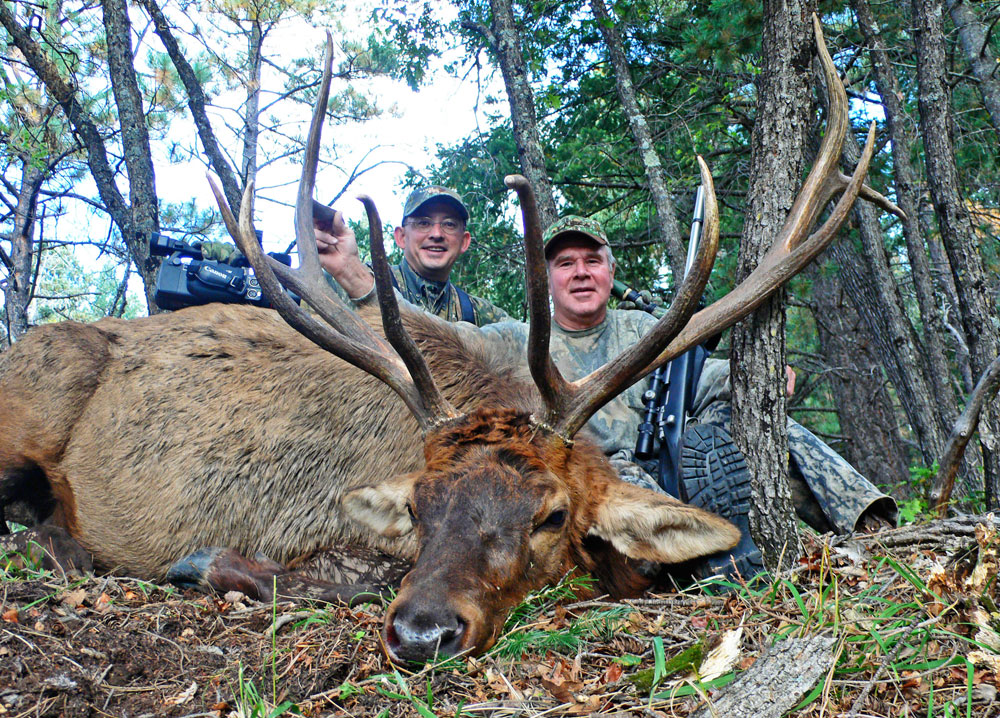
What about the Importance of Videoing?
I love to video hunts and put them on “Ramos Hunts and Video” on YouTube to share the excitement of these hunts and these hunters with friends and relatives. I have at least 70 videos, which not only include elk, but also javelinas, white-tailed deer, antelopes, oryx and turkeys. I not only want to share these hunts with people, but I want to show them the techniques I use to call the elk in to within bow range and also tactics for calling in turkeys and other animals. For me, sharing a video is easier than my telling a story. Then the hunters can see and understand how, why and when we call, set up and take the shot. The other big benefit for videoing the hunt is that after the shot is taken, I can see where the arrow hits, how the elk reacts to the hit, and get a better idea about when we should go after the elk to try to recover him.
In my videos, after the shot, I turn my camera on me and explain what just happened, why I’ve used the calls I have, why we’ve set-up where we’ve set up, and what’s every element of the hunt. I guess I do that because that’s the teacher in me coming out. I’ve taught for many years, been a principal and then an interim superintendent. Today, I’m the permanent superintendent of our schools. I enjoy teaching others how to use calls to get elk in close enough to take them with bows or guns. I like to teach hunters how to go out and have a great elk hunt, because most hunters don’t draw an elk tag every year. When they do draw a tag, that’s a special hunt for them, and I want to teach them all I can about elk hunting to make their hunts successful.














